Introduction
- Ethical leaders build trust with the followers through the creation of duty-based or covenantal relationships.
- Ethical leaders create covenantal relationships with the organization stakeholders:
- Employees;
- Customers;
- Shareholders.
- Ethical leadership creates a balance between instrumental and normative priorities.
- Ethical leaders have the ability to define the reality.
- Elements of ethical leadership include:
- Leadership;
- Interpersonal trustworthiness;
- Ethical stewardship.
Vast literature asserts that ethical leaders should have the ability to establish a trust with the followers through the creation of duty-based or covenantal relationships (Caldwell, Hayes & Long, 2010). Often, ethical leaders create covenantal relationships with the organization stakeholders including employees, customers and shareholders. Essentially, ethical leadership creates a balance between instrumental or goal-related and normative or value-based priorities (Bews & Rossouw, 2002). Besides, leaders should view their roles as covenantal. In other words, leaders should indicate the ability to define the reality. Moreover, leaders should have extra ordinary understanding of the situation beforehand. Since ethical leaders are capable of understanding the nature of being ethical, they have to establish organizational controls and support system that create high commitment (Chemers, 1997). Three important elements tend to provide insight on the concept of ethical leadership. The constructs include leadership, interpersonal trustworthiness and ethical stewardship. Essentially, the elements tend to emphasizes on the trust between the leader and the followers. The role of trustworthiness and the significance of ethically virtuous stewardship are critical in the relationship between the leader and the follower (Bews & Rossouw, 2002). Studies have indicated the importance of the gap between the follower and the leader, which has been identified as undermining the employees’ commitment, impairs wealth creation and increases the transaction cost within the organization (Caldwell et al, 2010). In other words, trustworthiness and ethical stewardship plays a critical role in ensuring the maintenance of employees, wealth creation and reduction of the operation costs.
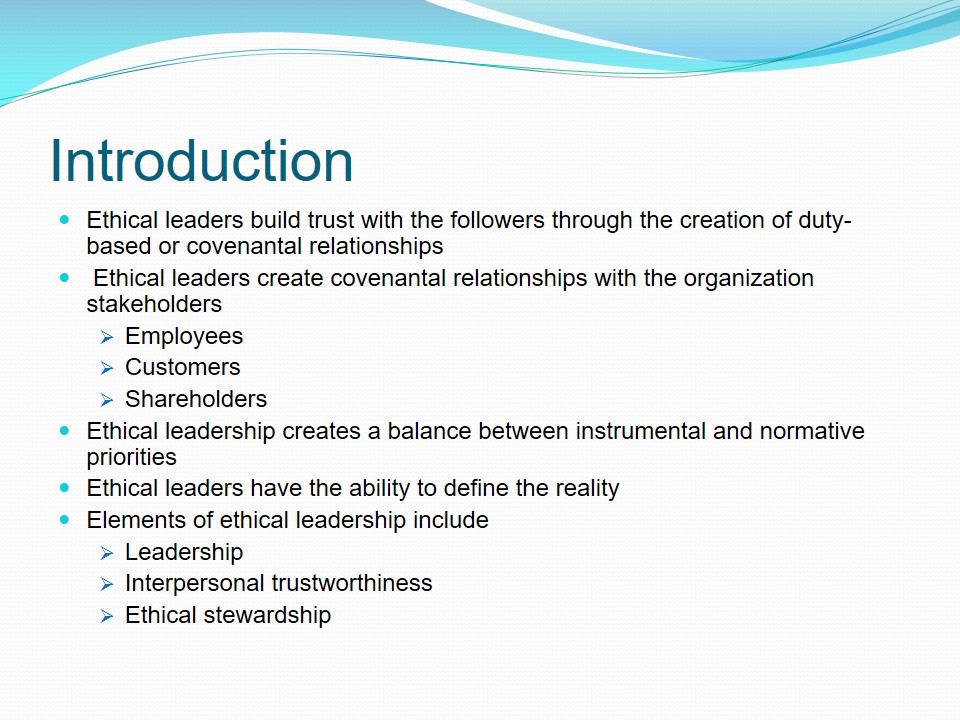
Models of Leadership
- Leadership is the capability of influencing followers towards attaining the organizational objectives through the creation of change.
- Theoretical models explaining leadership include:
- Personality models;
- Behavioral traits.
- The three-factor model of leadership falls under the personality and trait theories of leadership.
- The three-factor model explains three critical tasks of leadership.
- Leadership have three critical tasks that include:
- Relationship development;
- Resources utilization;
- Image management.
Leadership is the capability of influencing followers towards attaining the organizational objectives through the creation of change (Caldwell et al., 2010). Various theoretical framework including personality and behavioral traits explains the leadership processes and attributes as well as roles and behaviors. The three-factor model of leadership falls under the personality and trait theories of leadership and explains three critical tasks of leadership (Chemers, 1997). The tasks include relationship development, resources utilization and image management.
Relationship development is the interactions through which leaders develop relationships and identifies the desired outcome (Caldwell et al., 2010). In addition, relationship development also involves evaluation of how the results are attained as well as the maintenance of increased levels of personal commitment particularly from the stakeholders.
Resources utilization involves sourcing for resources including human and financial, creating a balance between competing demands as well as efficient and effective management of resources to attain the desired results (Caldwell et al., 2010).
Image management is the process of creating behaviors that are essential in building the reputation taking into consideration personal beliefs and that of the organization as well as aligning the expectations of the followers and personal behavior image (Chemers, 1997).
Essentially, the three factors interact together to result in ethical considerations in leadership capabilities. Besides, the three-fact models of leadership compliments the elements of interpersonal trustworthiness and ethical stewardship in the appropriate management of organizations.
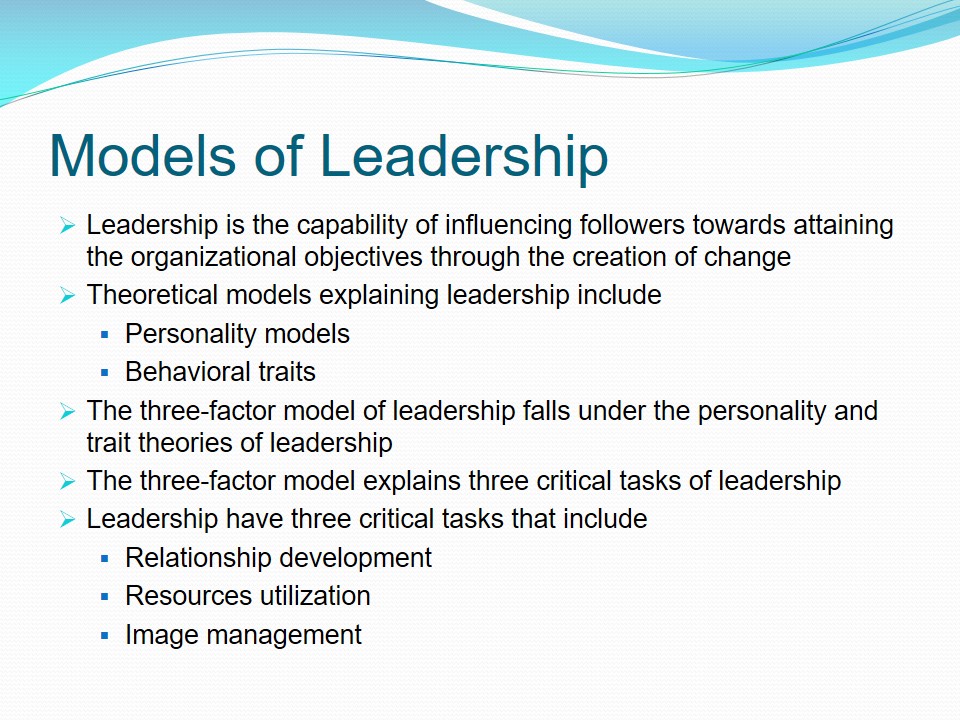
Relationship management
- Relationship development is the interactions through which leaders develop relationships and identifies the desired outcome.
- Evaluates how the results are attained.
- Maintain increased levels of personal commitment.
- People centered.
- Creates personal relationships that increase shared ownership and commitment.
- Supported by service-oriented model that emphasizes on emotional intelligence and commitment to employees success.
As indicated, Relationship development is the interactions through which leaders develop relationships and identifies the desired outcome. In addition, relationship development also involves evaluation of how the results are attained as well as the maintenance of increased levels of personal commitment particularly from the stakeholders (Caldwell et al., 2010). Moreover, relationship management mirrors the people centered focus on leadership. In other words, relationship management involves creating individual connection with others to augment shared ownership and commitment to the organization (Chemers, 1997). Essentially, leaders that tend to generate dyadic correlations increases the probability of establishing long-term commitment and trust. Ideally, developing effective relationships is a critical factor in building trust at interpersonal level (Mayer, Davis & Schoorman, 1995). Further, skilled leaders need to develop internal and external social capital to get the best out of the followers especially when the followers are under pressure to attain the desired goal (Chemers, 1997). Increased trust comes about when leaders adopt service-oriented model that emphasizes on emotional intelligence and commitment to employees success (Caldwell et al., 2010).
Essentially, relations management focuses on the people-centered form of leadership in which share ownership and commitment is highly emphasized. In addition, behaviors and actions that focus on building trust is critical in building long-term relationships, which is beneficial to the firm. Studies indicate that leaders that develop affective connections have increased likelihood of building long-term trust (Caldwell et al., 2010).
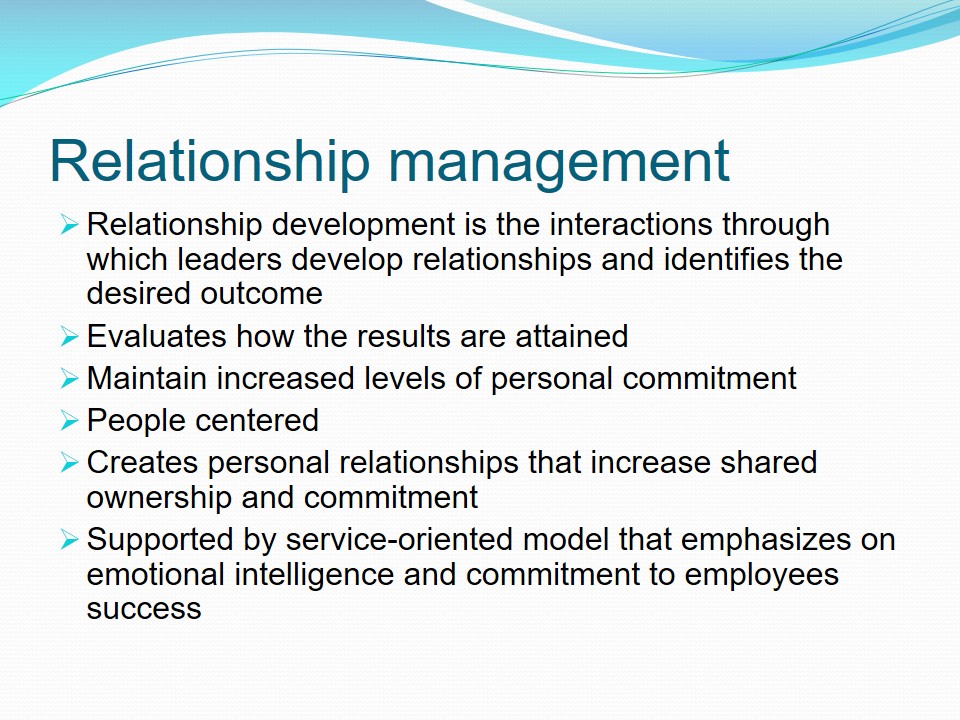
Resource Utilization
- Resources utilization involves:
- Sourcing for resources ranging from human to financial;
- Creating a balance between competing demands;
- Efficient and effective management of resources to attain the desired results;
- Harnessing the information to gain profound knowledge critical in decision-making process;
- Emphasize on job-centered leadership attributes required in:
- Resources acquisitions;
- Offering direction to the employees based on clear goals and roles;
- Enforcement of standards.
Resources utilization involves sourcing for resources ranging from human to financial. In addition, resources utilization involves creating a balance between competing demands as well as efficient and effective management of resources to attain the desired results (Caldwell et al., 2010). Unlike relationship management, behaviors intrinsic in resource utilization emphasize on job-centered leadership attributes that is required in resources acquisitions. Besides, such behaviors are critical in offering direction to the employees based on clear goals and roles as well as enforcement of standards (Collins, 2005). Availability of resources increases the firms’ competitive advantage. Essentially, resources acquisition element of strategic leadership involves creating human and social capital within the firm as well as financial resources (Collins, 2005). Resources utilization also involves harnessing the information to gain profound knowledge critical in decision-making process (Mayer et al., 1995).
Resources utilization also involves source for resources and utilizing the resources to increase the firm’s competitive advantage. According to Mayer et al. (1995), resources are the foundations for the firm’s competitive advantage and strategies. In other words, the ability of the leaders to harness, coordinate and develop the resources for the improvement of the firm. Besides, the organization leaders have to show the personalized competence in the resources management and effective decisions that affect the firm and its stakeholders (Collins, 2005). In order to attain the required outcome, efficiency and cooperation is greatly necessary.
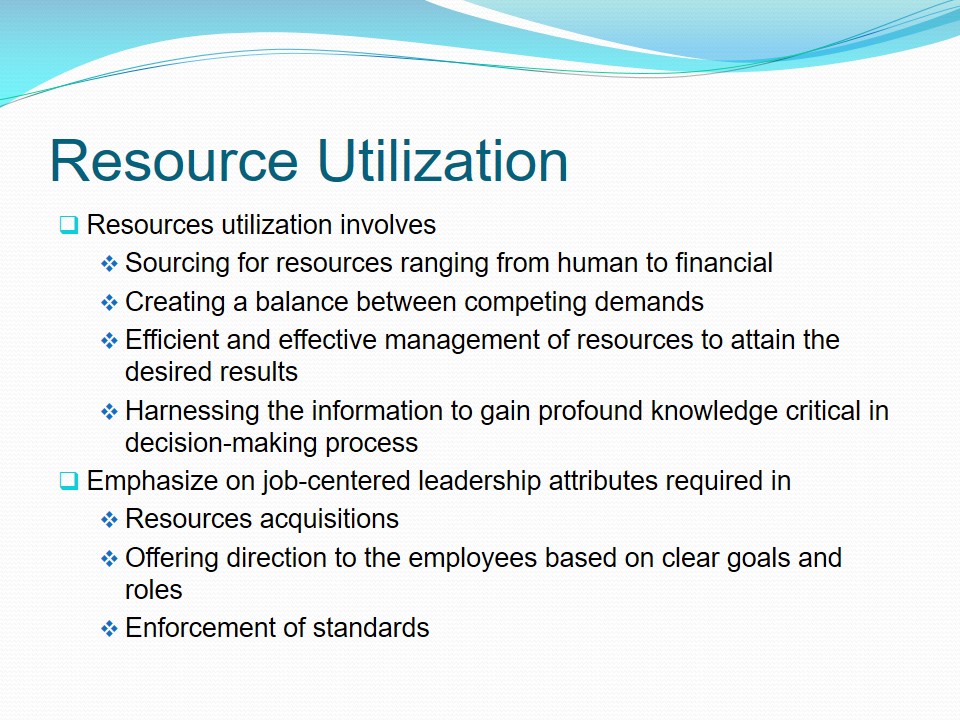
Image Management
- Image management is the process of creating behaviors critical in:
- Building the reputation;
- Aligning the expectations of the followers and personal behavior image;
- Involves leaders acting according to their beliefs and claims in order to earn trust and followership of employees.
As mentioned, Image management is the process of creating behaviors that are essential in building the reputation taking into consideration personal beliefs and that of the organization as well as aligning the expectations of the followers and personal behavior image (Chemers, 1997). Essentially, image management involves leaders acting according to their beliefs and claims in order to earn trust and followership of employees. Most successful leaders demonstrate personal commitment to the wellbeing of the organization (Block, 1993). In other words, such leaders put the interest of the organization and its stakeholders first before their personal interest. Moreover, successful leaders show the courage to follow their core ideology as well as founding values. Such leaders stand strong against challenges to their core principles. As such, image management requires leaders’ ability to demonstrate such substance instead of merely a style (Caldwell et al., 2010).
Focusing on the interest of the society and organization as well as emphasizing on the personal core values forms the core principles of image management. Therefore, leaders have to demonstrate the personal zeal for the interest of the organization and its stakeholders instead of being seen as concerned with fulfilling their personal ambitions and goals (Collins, 2005). Essentially, leaders have to strive to maintain the image that reflects their commitment to the organization and its stakeholders instead of building their personal reputation. In fact, the most effective leader focus on building an organization culture and systems that enable all the stakeholders be successful and demonstrate not only a passion for excellence but also personal humility.
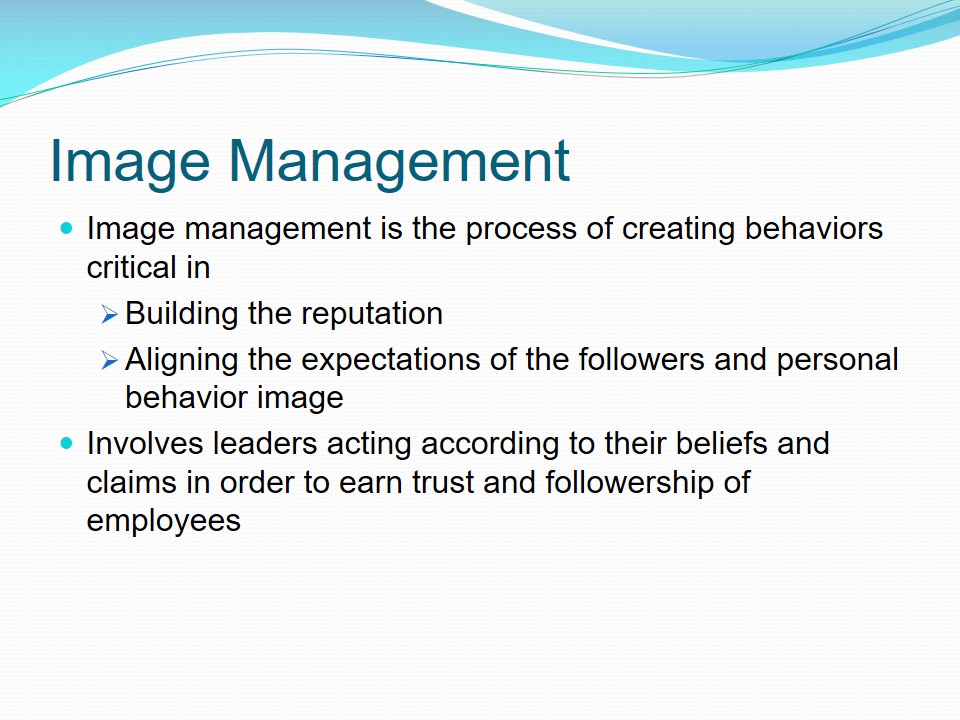
The Manner in which Leaders Serve as Role Models
- Core principles and ideologies form the basis of their daily engagement.
- Demonstrate the ability to stand by the core values and principles.
- Demonstrate job-centered leadership attribute.
- Win trust among the followers.
- Provide direction to the employees based on clear goals and roles.
Serving as a role model is one of the attributes that ethical leaders should possess in order to earn trust. Leaders acting according to their beliefs and claims earn increased trust and followership among employees (Mayer & Gavin, 2005). Moreover, leaders should demonstrate courage and follow their core ideology as well as founding values. Besides, leaders should stand strong against challenges to their core principles, which dictate their behaviors towards the subordinates and the organization stakeholders. The ability to stand by the core values and principles that bring about the success to the organization is a role model to the junior employees. Moreover, leaders showing job-centered leadership attribute critical in offering direction to the employees based on clear goals and roles as well as enforcement of standards serve as an example to the stakeholders (Mayer et al., 1995).
Essentially, attaining the organization goals through the application of strategies that take into consideration the interest of stakeholders and the society is critical for leaders. As indicated, emphasizing on the personal core principles geared towards obtaining the desired outcome, the ability to show the job-centered attributes as well as taking into consideration the needs of the stakeholders and the society are positive attributes that remain symbolic and admired by the junior staff within the organization (Caldwell et al., 2010). In reality, leaders’ behavior should incorporate all the elements of leadership, interpersonal trustworthiness as well as the ethical stewardship.
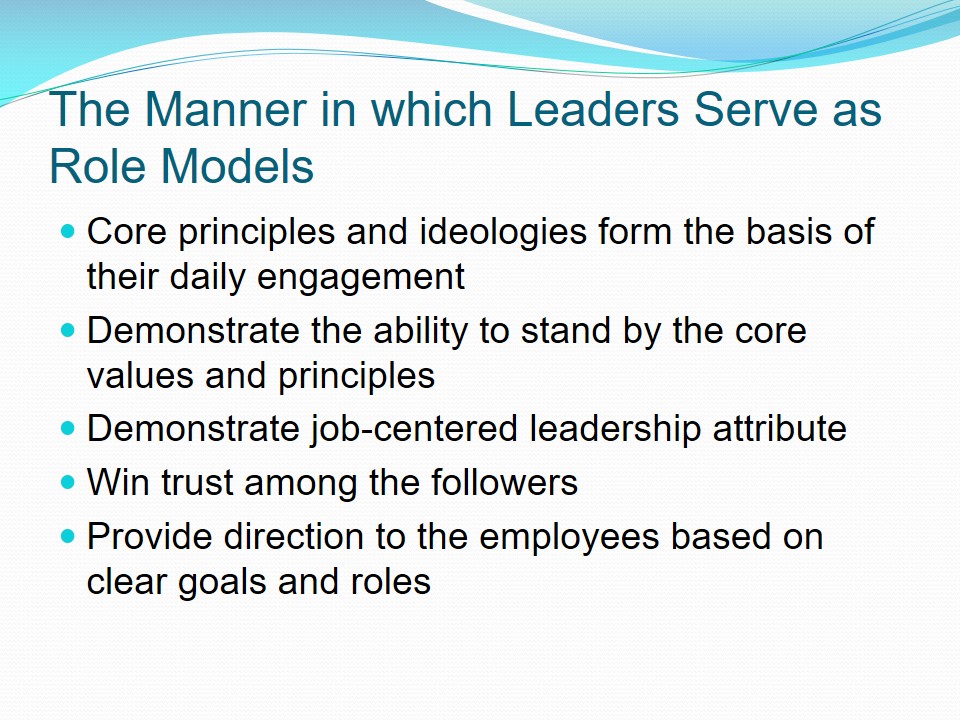
Interpersonal Trustworthiness
- The ability of an individual to evaluate the probability that another person can be trusted to honor obligations inherent within perceived social contract;
- Involves leader follower relationship contracts;
- Originate from the degree of covenantal relationship;
- Is based on:
- Ability;
- Benevolence;
- Integrity.
Interpersonal trustworthiness is the ability of an individual to evaluate the probability that another person can be trusted to honor obligations inherent within perceived social contract (Caldwell et al., 2010). The leader follower relationships are considered social contracts that originate from the degree of covenantal relationship. Ability, benevolence and integrity form the basis of interpersonal trustworthiness (Mayer & Gavin, 2005). Ability is the skills, competencies and attributes that enable an individual have influence over others (Caldwell et al., 2010). Benevolence is the degree to which an individual is believed to want to do well for the benefit of others (Caldwell et al., 2010). Integrity is the belief that the leader is capable of adhering to the set rules and principles that the followers find acceptable (Mayer & Gavin, 2005). The three factors, ability, benevolence and integrity forms the basis of the interpersonal trustworthiness three factor model and regarded as the cost-conscious measure of trustworthiness. According to the framework, individual decisions depend on the combination of multifaceted demographic and personal factors that are based on the personal history, background, sex, age and the expectations of the world (Mayer & Gavin, 2005). The elements of interpersonal trustworthiness determine the leadership qualities. The perceived trust are indicated in the leadership ability, benevolence and integrity, which are the major elements of interpersonal trustworthiness (Mayer et al., 1995).
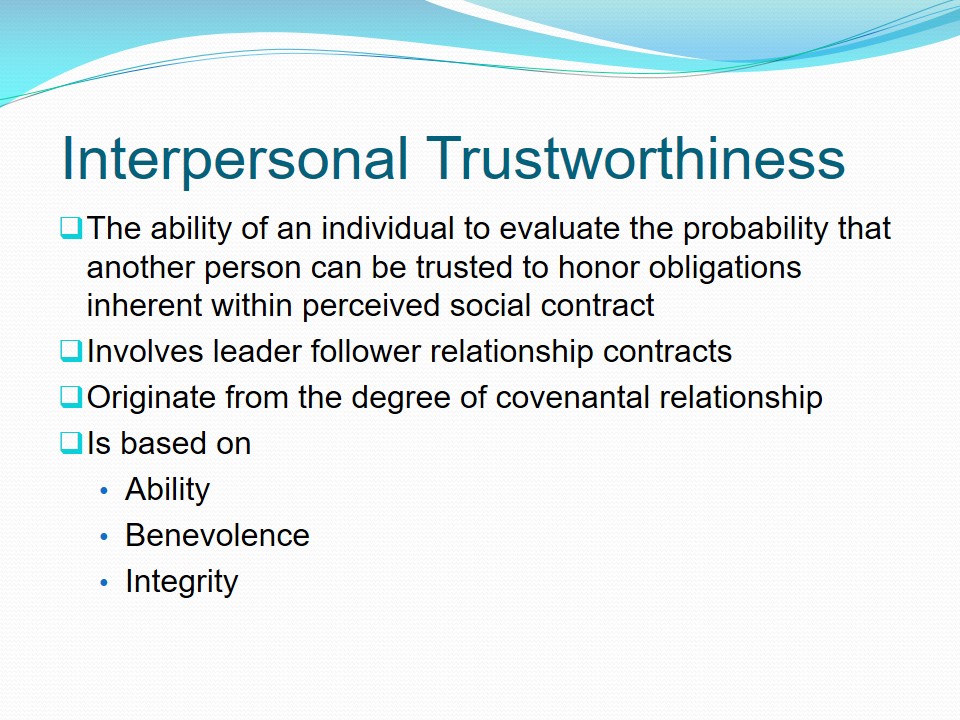
Interpersonal Trustworthiness and Leadership
- Leaders’ behaviors are assessed based on:
- Their perception about the followers;
- Personal goals;
- The divine;
- Past experiences;
- Current realities;
- Future expectations;
- In terms of interpersonal trustworthiness three-factor model leaders earn trust through:
- Personal accountability;
- Honoring the commitment owed to integrate both instrumental and normative values and goals .
As indicated, individuals make personal decisions based on the personal history, background, sex, age and the expectations of the world. In fact, leaders’ behaviors are assessed based on their perception about the followers, personal goals, and the divine, past experiences, current realities and the future expectations (Gill, Boies, Finegan & McNally, 2005). According to interpersonal trustworthiness three-factor model, leaders earn trust and followership through being accountable. In addition, leaders earn trust through the virtue of honoring the commitment owed to integrate both instrumental and normative values and goals (Murphy, 2009). For instance, trustworthy leaders demonstrate a morally virtuous commitment, which other are willing to follow. Through the virtue of honoring their duties and responsibilities to others, leaders demonstrate their commitment to the covenantal nature of the relationship they have with the followers (Mayer & Gavin, 2005). In connection with the three dimensions of leadership, the behaviors associated with resources utilization influences individual perception of interpersonal trustworthiness. In addition, leader’s behavior associated with relationship development management influences individual perception of interpersonal trustworthiness. Finally, leadership behaviors associated with image management influences individuals’ perception of interpersonal trustworthiness.
The elements of interpersonal trustworthiness impacts on the level of trust the followers have on the leader. In other words, perceived trust between the leader and the follower are indicated in the leadership ability, benevolence and integrity, which are the major elements of interpersonal trustworthiness (Mayer et al., 1995).
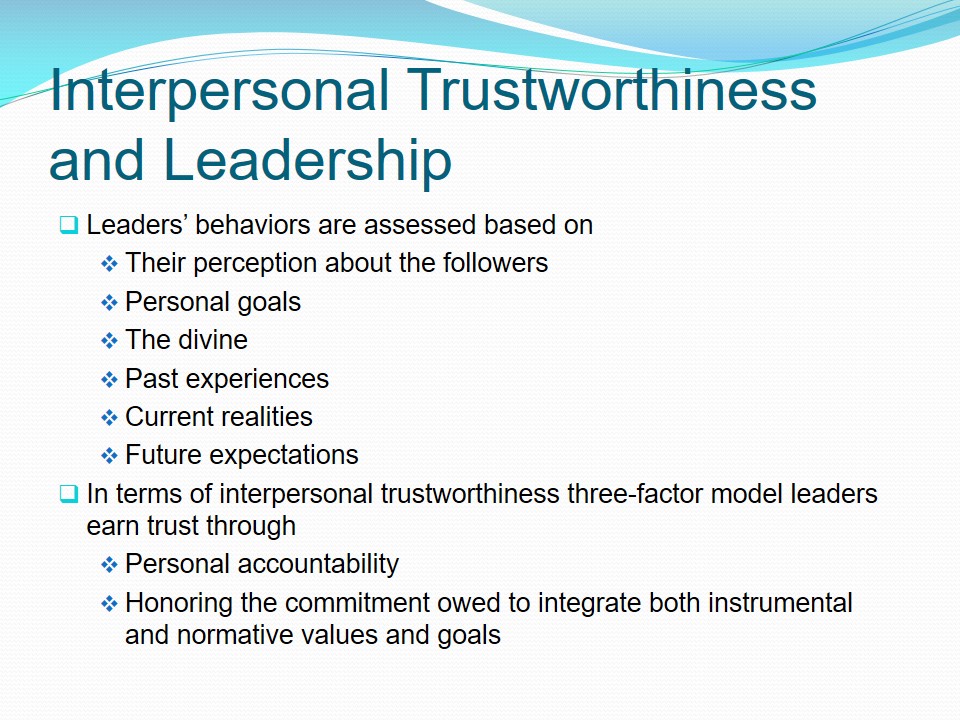
Ethical Stewardship
- Ethical stewardship is the greater degree of governance in which the motivations of the manager are based on the organizational commitments rather than personal interests and behaviors
- Leaders have the responsibility of:
- Maximizing long-term wealth creation;
- Integrating shared interest;
- Helping the organization and the stakeholders to self-actualize their ambitions, goals and objectives;
- Ethical steward leaders emphasizing on the provision of services rather than pursuing personal ambitions.
The concept of ethical stewardship is the greater degree of governance in which the motivations of the manager are based on the organizational commitments rather than personal interests and behaviors (Murphy, 2009). The concept of stewardship is based on the premise that leaders have greater responsibilities more than just the duties of sharing resources. According to the concept, leaders have the responsibility of maximizing long-term wealth creation to benefit the organization as well as the societies in which the organization operates (Mayer & Gavin, 2005). In addition, the leaders have the responsibility of integrating the shared interest as well as help the organization and the stakeholders to self-actualize their ambitions, goals and objectives. In fact, stewards pursue the optimization of wealth creation through generating relationships that maximizes the stakeholders’ ownership and commitment. Ethical stewardship roles are also defined as emphasizing on the provision of services rather than pursuing personal ambitions (Mayer & Gavin, 2005). For instance, ethical steward leaders would attain both organizational and individual goals through treating the followers equally like the owners and partners of the organization. Essentially, stewards treat their followers with profound concern for their welfare and honor the responsibility of the organization (Murphy, 2009).
Besides, steward leaders balance the public interest and the need of the organization. In other words, the level of stewardship is reached when the leader take into consideration the interest of the society as well as other stakeholders while creating long-term wealth of the organization (Mayer & Gavin, 2005).
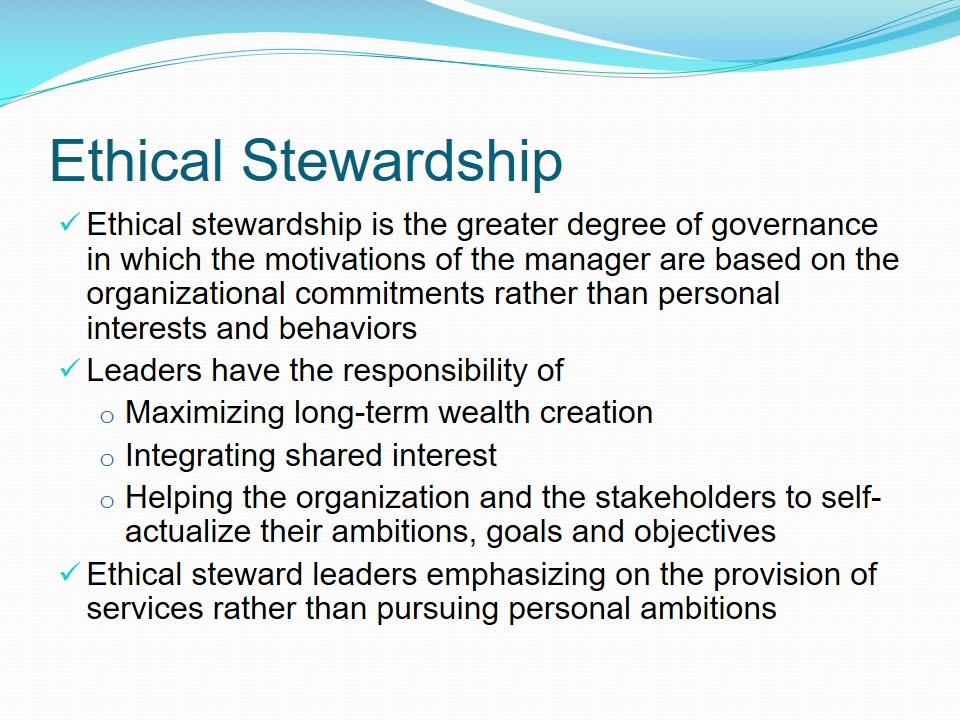
The views of Caldwell, Hayes and Long on ethical stewardship
- Caldwell, Hayes and Long argue that.
- Ethical steward leaders have the responsibility of optimizing the long-term wealth creation that benefits all the stakeholders.
- Attaining the long-term wealth creation to the organization is the main responsibility of steward leaders.
- In agreement with Caldwell et al assertions.
- Ethical steward leaders avoid short-term self-defeating decisions that inflate the market value and impair the fundamental mission of the firm.
- Ethical steward leaders are supposed to honor the transformational obligations that create new opportunities that the organization can exploit for its advantage.
- Leaders should be committed to improve the welfare of the organization stakeholders as well as growth and development of the firm.
According to Caldwell, Hayes and Long (2010), ethical steward leaders have the responsibility of optimizing the long-term wealth creation that benefits all the stakeholders of the organization. In fact, attaining the long-term wealth creation to the organization is the main responsibility of steward leaders (Caldwell et al., 2010). In order to attain the long-term benefits to the organization, leaders would avoid short-term decisions that are normally influenced by personal interest rather than that of the organization and the stakeholders. In most cases, short-term self-defeating decisions that inflate the market value and impair the fundamental mission of the firm (Caldwell et al., 2010). For instance, a firm may be lured to follow the seductions of Wall Street model that advocate for short-term financial targets and stock prices. Essentially, leaders should be committed to improve the welfare of the organization stakeholders as well as growth and development of the firm. Moreover, leaders are supposed, to honor the transformational obligations that create new opportunities that the organization can exploit for its advantage (Caldwell et al., 2010).
Essentially, when the leader seek to optimize the needs of the society, customers as well as other stakeholders while pursuing the long-term wealth of the organization, the level of ethical stewardship is achieved by the leader (Caldwell et al., 2010). Critically, the theoretical approach to stewardship incorporates the virtuous ethics, which is based on the congruence between the public good and the interest of the organization.
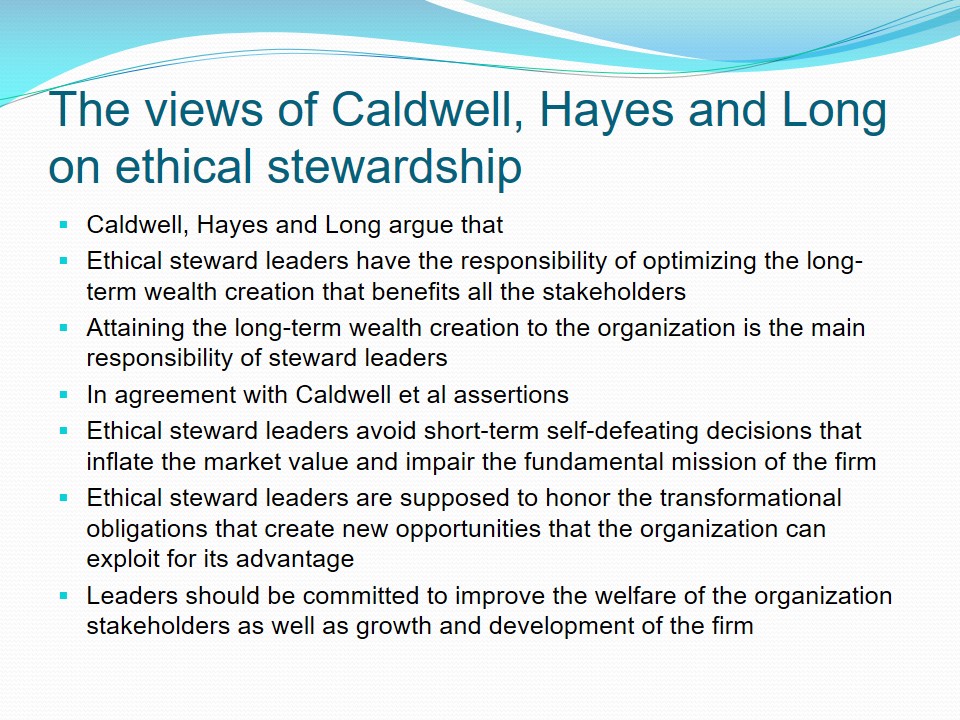
The Correlation between Leadership, Interpersonal Trustworthiness and Ethical Stewardship
- Trust is the most closely related to leadership.
- The correlation model confirms the hypothesis that:
- Resources utilization influences individual perception of interpersonal trustworthiness;
- Relationship management influences individual perception of interpersonal trustworthiness;
- Image management influences individuals’ perception of interpersonal trustworthiness;
- Personal commitment based on indifference, trust and acceptance helps in attaining meaningful long-term wealth creation.
Trust is widely accepted as closely related to leadership. In other words, the constructs of interpersonal trustworthiness have close connections with the elements of leadership (Mayer et al., 1995). As indicated, in connection with the three dimensions of leadership, the behaviors associated with resources utilization influences individual perception of interpersonal trustworthiness. In addition, leader’s behavior associated with relationship development management influences individual perception of interpersonal trustworthiness (Caldwell et al., 2010). Finally, leadership behaviors associated with image management influences individuals’ perception of interpersonal trustworthiness. Essentially, the decision to trust and relinquishing of personal control to another party with the expectation and hope that the person will honor express or implied duties between the parties is the expected outcome of leadership (Mayer et al., 1995). Moreover, when the organization stakeholders willingly surrender their personal commitment within the precincts of indifference, trust and acceptance, then the organization is capable of obtaining the level of personal investment needed to attain the meaningful long-term wealth creation as required in ethical stewardship (Gill et al., 2005).
The relationship between leadership and interpersonal trustworthiness is clearly observed in the attributes of leaders. The perceived trust between the leader and the follower are indicated in the leadership ability, benevolence and integrity, which are the major elements of interpersonal trustworthiness (Mayer et al., 1995). Similarly, the relationship between leadership and ethical stewardship is seen in the consideration of the public interest while pursuing the long-term wealth creation of the organization.
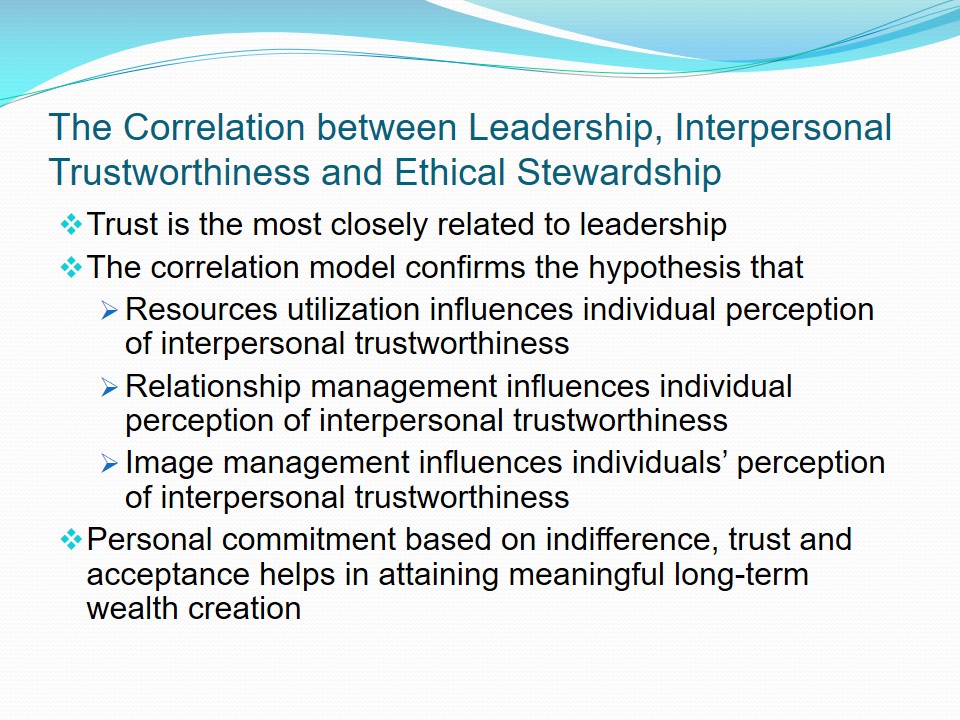
Interrelationship Model
- Relationship between leadership and interpersonal trustworthiness also exists in ethical stewardship:
- Leadership behaviors associated with resources utilization influences individual perception of interpersonal trustworthiness and ethical stewardship;
- Leadership behavior associated with relationship development management influences individual perception of interpersonal trustworthiness as well as ethical stewardship;
- Leadership behaviors associated with image management influences individuals’ perception of interpersonal trustworthiness and ethical stewardship.
The model indicates the manner in which leadership, interpersonal trustworthiness and ethical stewardship constructs are interlinked. To show how interpersonal trustworthiness connects to the three dimensions of leadership, the behaviors associated with resources utilization influences individual perception of interpersonal trustworthiness. In addition, leader’s behavior associated with relationship development management influences individual perception of interpersonal trustworthiness (Caldwell et al., 2010). Finally, leadership behaviors associated with image management influences individuals’ perception of interpersonal trustworthiness. In relation to ethical stewardship leadership behaviors associated with resource utilization influences ethical stewardship. Besides, leader’s behavior associated with relationship development management influences individual perception of ethical stewardship and leadership behaviors associated with image management influences individuals’ perception of ethical stewardship.
Trust is widely accepted as critical attribute related to leadership. The perceived trust between the leader and the follower incorporates the model of ability, benevolence and integrity, which are the major elements of trustworthiness (Caldwell et al., 2010). In other words, ability, benevolence and integrity are antecedents to trust in leadership. Moreover, the individual perception the simplicity or uncertainty of information as well as the context of situation have positive or negative impact on trust decisions. Similarly, when the leader seek to optimize the needs of the society, customers as well as other stakeholders while pursuing the long-term wealth of the organization, the leader is said to have risen to the level of ethical stewardship (Caldwell et al., 2010). The theoretical approach to stewardship incorporates the virtuous ethics, which is based on the congruence between the public good and the interest of the organization.
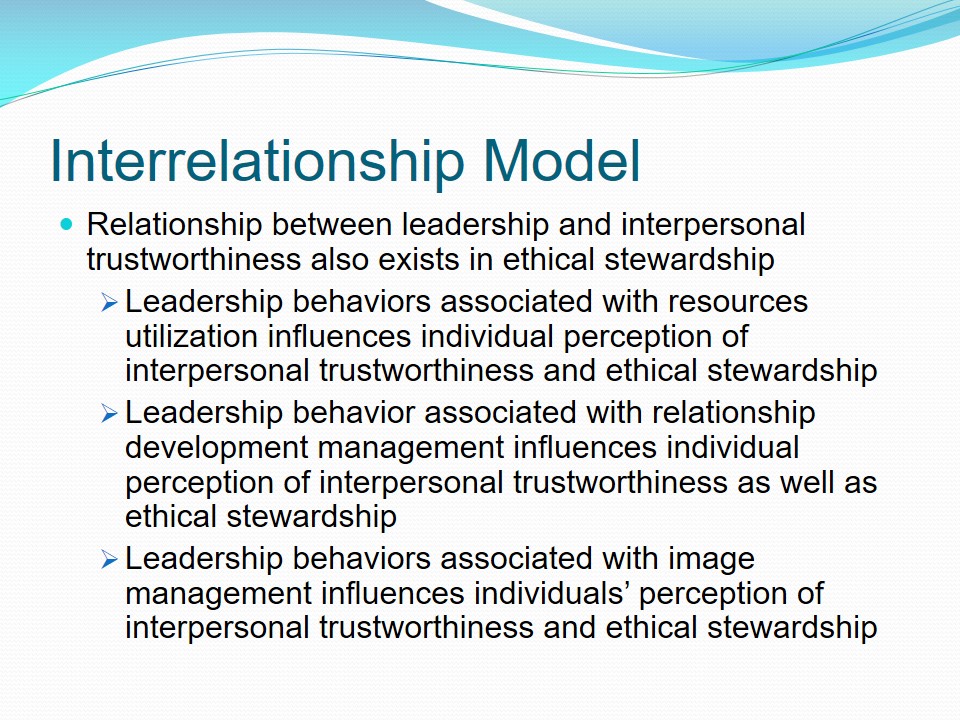
Conclusion
Elements of ethical leadership include:
- Leadership which is determined by:
- vRelationship development;
- vResources utilization;
- vImage management;
- Interpersonal trustworthiness.
- Ethical stewardship.
Ethical leadership is defined within the elements of leadership, interpersonal trustworthiness and ethical stewardship. Leadership is the capability of influencing followers towards attaining the organizational objectives through the creation and managing change. The three-factor model of leadership explains the roles and tasks necessary in ethical leadership. The tasks include relationship development, resources utilization and image management.
Relationship development is the interactions through which leaders develop relationships and identifies the desired outcome. In addition, relationship development also involves evaluation of how the results are attained as well as the maintenance of increased levels of personal commitment particularly from the stakeholders. Resources utilization involves sourcing for resources including human and financial, creating a balance between competing demands as well as efficient and effective management of resources to attain the desired results. Image management is the process of creating behaviors that are essential in building the reputation taking into consideration personal beliefs and that of the organization as well as aligning the expectations of the followers and personal behavior image.
On the other hand, interpersonal trustworthiness is the ability of an individual to evaluate the probability that another person can be trusted to honor obligations inherent within perceived social contract. Similarly, the concept of ethical stewardship is the greater degree of governance in which the motivations of the manager are based on the organizational commitments rather than personal interests and behaviors. All relate and influences each other to create a model of ethical leadership that should be adopted for the success of the organization.
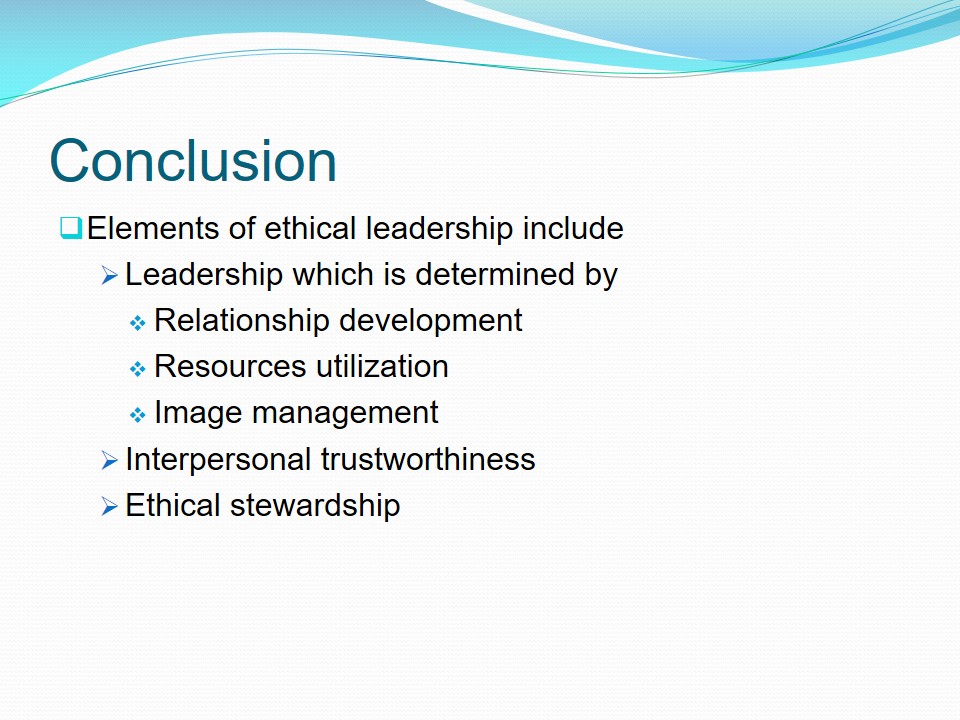
References
Bews, N. F., & Rossouw, G. J. (2002). A role for business ethics in facilitating trustworthiness. Journal of Business Ethics, 39(4), 377–390.
Block, P. (1993). Stewardship: choosing service over self-interest. San Francisco: Berrett-Koehler Publishers.
Caldwell, C., Hayes, L. A. & Long, D. T. (2010). Leadership, trustworthiness, and ethical stewardship. Journal of Business Ethics, 96(4), 497–512.
Chemers, M. M. (1997). An integrative theory of leadership. Mahwah, NJ: Lawrence Erlbaum Associates.
Collins, J. (2005). Level 5 Leadership: The Triumph of Humility and Fierce Resolve. Harvard Business Review 83(7), 136–143.
Gill, H., Boies, K., Finegan, J., & McNally, J. (2005). Antecedents of trust: establishing a boundary condition for the relation to propensity to trust and intention to trust. Journal of Business & Psychology 19(3), 287–302.
Mayer, R. C. & Gavin, M. B. (2005), Trust in management and performance: who minds the shop while the employees watch the boss? Academy of Management Journal, 48(5), 874–888.
Mayer, R. C., Davis, J. H. & Schoorman, F. D. (1995). An integration model of organizational trust. Academy of Management Review, 20(3), 709–729.
Murphy, P. E. (2009). The relevance of responsibility to ethical business decisions. Journal of Business Ethics, 90(1), 245–252.